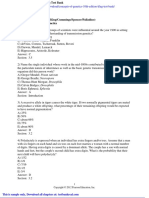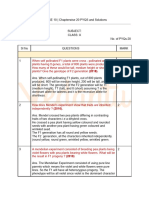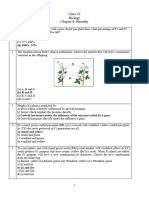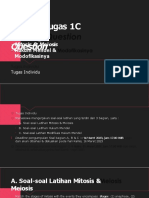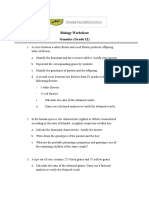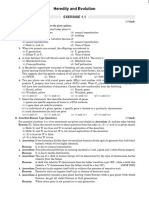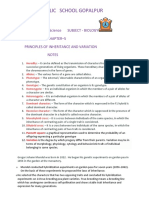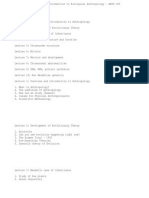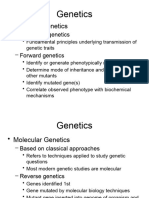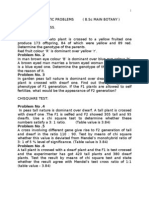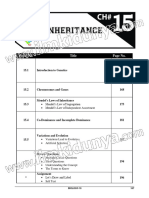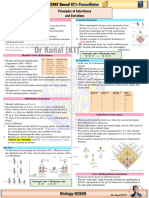0 ratings0% found this document useful (0 votes)
20 viewsBio WS
Bio WS
Uploaded by
rrathnagirisrvtrycbseviiThis document contains questions about heredity and genetics concepts taught in a biology worksheet. Some of the key topics covered include Mendel's laws of inheritance, dominant and recessive traits, monohybrid and dihybrid crosses, and the 9:3:3:1 phenotypic ratio that results from a dihybrid cross. The questions test understanding of heredity, genes, chromosomes, phenotypes, genotypes, inheritance patterns, and concepts discovered through Mendel's experiments with pea plants.
Copyright:
© All Rights Reserved
Available Formats
Download as PDF, TXT or read online from Scribd
Bio WS
Bio WS
Uploaded by
rrathnagirisrvtrycbsevii0 ratings0% found this document useful (0 votes)
20 views4 pagesThis document contains questions about heredity and genetics concepts taught in a biology worksheet. Some of the key topics covered include Mendel's laws of inheritance, dominant and recessive traits, monohybrid and dihybrid crosses, and the 9:3:3:1 phenotypic ratio that results from a dihybrid cross. The questions test understanding of heredity, genes, chromosomes, phenotypes, genotypes, inheritance patterns, and concepts discovered through Mendel's experiments with pea plants.
Copyright
© © All Rights Reserved
Available Formats
PDF, TXT or read online from Scribd
Share this document
Did you find this document useful?
Is this content inappropriate?
This document contains questions about heredity and genetics concepts taught in a biology worksheet. Some of the key topics covered include Mendel's laws of inheritance, dominant and recessive traits, monohybrid and dihybrid crosses, and the 9:3:3:1 phenotypic ratio that results from a dihybrid cross. The questions test understanding of heredity, genes, chromosomes, phenotypes, genotypes, inheritance patterns, and concepts discovered through Mendel's experiments with pea plants.
Copyright:
© All Rights Reserved
Available Formats
Download as PDF, TXT or read online from Scribd
Download as pdf or txt
0 ratings0% found this document useful (0 votes)
20 views4 pagesBio WS
Bio WS
Uploaded by
rrathnagirisrvtrycbseviiThis document contains questions about heredity and genetics concepts taught in a biology worksheet. Some of the key topics covered include Mendel's laws of inheritance, dominant and recessive traits, monohybrid and dihybrid crosses, and the 9:3:3:1 phenotypic ratio that results from a dihybrid cross. The questions test understanding of heredity, genes, chromosomes, phenotypes, genotypes, inheritance patterns, and concepts discovered through Mendel's experiments with pea plants.
Copyright:
© All Rights Reserved
Available Formats
Download as PDF, TXT or read online from Scribd
Download as pdf or txt
You are on page 1of 4
G10-BIOLOGY WORKSHEET ON HEREDITY
1. Select the group which shares maximum number of common characters.
(a)two genera of two families; (b)two species of a genus; (c) two genera of a family;
(d) two individual of a species
2. Two pea plants one with round green seeds (RRyy) and another with wrinkled yellow (rrYY) seeds
produce F1 progeny having round yellow (RrYy) seeds. When F 1 plants are selfed, the F2 progeny will have
the following combination of characters.
(a) 15:1; (b) 9:3:3:1; (c) 9:3:4; (d) 12:3:1
3. What is monohybrid cross?
4. What are autosomes and sex chromosomes?
5. Name the scientist who gave the Principles of Inheritance
6. Which of the following is not correct- (a) for every hormone there is a gene (b) for every protein there is
a gene (c) for production of every enzyme there is a gene (d) for every molecule of fat there is a gene
7. Who coined the term ‘gene’?
8. What are dominant genes?
9. If a round green seeded pea plant (RRYY) is crossed with wrinkled yellow seeded pea plant (rryy) the
seeds to be produced in F1 generation will be: (a) Wrinkled yellow; (b) round green; (c) wrinkled green (d)
round yellow
10. The genetic constitution of an organism is called
11. Write the scientific name of the plant on which Mendel carried out his experiment
12. How many autosome are present in human sperm?
13. Two pink coloured flowers on crossing results in 1red, 2pink, and 1white flower progeny. The nature of
the cross is
(a) Cross pollination; (b) self pollination; (c) double fertilization; (d) no fertilization
14. Mendel proposed that every character is controlled by-
(a) 1 factor; (b) 2 factors; (c) 1 chromosome; (d) 2chromosomes
15. Who is called father of genetics?
16. Genetics is the study of
17. What is heredity?
18. What are Mendelian factors?
19. A Mendelian experiment consisted of breeding tall pea plants bearing violet flowers with short pea plant
bearing white flowers. The progeny obtained all bore violet flowers but almost half of them were short. This
suggest that the genetic makeup of the tall parental can be depicted as:
(a) TTWW; (b) TTww; (c) TtWW; (d) TtWw
20. What happened when Mendel crossed two traits of a character in a pea plants?
21. A normal pea plant bearing coloured flowers suddenly start producing white flowers. What could be the
possible cause
22. Mention any two recessive traits of garden pea.
23. Mendel crossed a pure white recessive pea plant with a dominant pure red flowered plant. What will be
the F1 generation?
24. Why males are called heterogametic?
25. What is the percentage possibility a couple of having daughters?
26. Why acquired traits are not inherited?
27. How do the two factors for a character, present in diploid cells, behave at the time gamete formation?
28. Give the pair of contrasting traits of the following characters in plant and mention which one is
recessive and dominant? (a)Yellow seed; (b) round seed
29. Mention the compliment of a sperm and the egg which will determine the birth of female child.
30. What is emasculation? Why is it done?
31. What is gene? Where are genes located?
32. How many contrasting characters did Mendel see in garden pea? Give any two of them.
33. What is phenotypic ratio obtained by Mendel by monohybrid cross? Answer with the help of diagram.
34. How is the chromosome number restored in zygote?
35. What are variations? Give their types
36. Differentiate between autosome and allosome
37. What will be the sex of the embryo if an egg is fertilized by the sperm having (a)22+X (b)22+Y
38. Mention two sources of variation.
39. What is monohybrid and dihybrid cross? Give one example of each
40. Why did Mendel Choose pea plant for his experiment?
41. If a trait A exists in 10% of a population of an asexually reproducing species and a trait B exists in 60%
of the same population, which trait is likely to have arisen earlier?
42. Why are traits acquired during the life-time of an individual not inherited?
43. When Mendel crossed a Tall plant with a dwarf plant, no medium height plants were obtained in F
generation. Why?
44. What will be the blood group of offspring’s produced by the parents having following genotype-
I o I A x I A IB
45. A woman with blonde curly hair married a man with black soft hair. All of their children in first
generation had black soft hair but in next generation children had different combinations in the ratio of
9:3:3:1.State the law that governs this expression.
46. Only variation that confer an advantage to an individual organism will survive in a population. Do you
agree with this statement? Why or Why not?
47. State three laws of Mendel
48. Describe how the sex of the offspring is determined in the zygote in human beings?
49. Give difference between diploid and haploid
50. Write similarities between Mendelian’s factors and gene.
51. How does the creation of variations in a species promote survival?
52. How do Mendel’s experiments show that traits may be dominant or recessive?
53. How do Mendel’s experiment shows that traits are inherited independently?
54. A man with blood group A marries a woman with blood group O and their daughter has blood group O.
Is this information enough to tell which of the traits-blood group A or O is dominant? Why or Why not?
55. A study found that children with light-coloured eyes are likely to have parents with light coloured eyes,
can we say anything about whether the light eye colour trait is dominant or recessive? Why or Why not?
56. Explain how sexual reproduction gives rise to more viable variations than asexual reproduction. How
does this affect the evolution of those organisms that reproduce sexually?
57. The gene type of green stemmed tomato plant is denoted as GG and that of purple stemmed tomato
plant as gg when these two are crossed (i) what color of stem would appear in F1 generation (ii) Give the
percentage of purple stemmed plant if F1 are self pollinated (iii) In what ratio would you find the gene
types GG and Gg in the F2 generation.
58. Study the given data and answer the questions following the data:
Parental plant cross fertilized F1 first generation F2 offsprings of self pollination of F1
and seeds collected offsprings
Male parents always bare red 330 seeds sown and Out of 44 seeds 33 seeds gave plants
flowers. Female parent always had observed. All 330 gave red with red flowers and 11 seeds gave
white flowers flowers plants with white flowers
(i) What is the term for this type of cross?
(ii) What does the data of the column marked F1 indicate?
(iii) Express the gene type of the (a) parents (b) F1 progeny (c) F2 progeny
59. (i) Who provided the evidence of DNA as genetic material?
(ii) Why DNA is called polynucleotide?
(iii) List three important features of double helical model of DNA
59. Give the basic features of the mechanism of inheritance
60. Outline a project which aims to find the dominant coat colour in dogs
61. which of the following is heterozygous? TTRR, ttrr, TT, Tt
62. The genotype of offspring formed from Ttxtt will be: TT&tt, Tt&tt, only tt, only TT
63. A recessive homozygous is crossed with a heterozygous of the same gene. What will be the phenotype of
the F1?
64. If a tall pea plant is crossed with a pure dwarf pea plant then, what percentage of F1 & F2 will be tall?
65. A homozygous dominant guinea pig with black fur is crossed with homozygous guinea pig with white
fur. The F1 generation is crossed with itself. What % of F2 generation is expected to show a white fur coat?
66. Two pea plants one with round green seeds (RRyy) & another with wrinkled yellow (rrYY) seeds
produce F1 progeny that have round, yellow (RrYy) seeds. When F1 plants are selfed, the F2progeny will
have a new combination mention it.
67. A heterozygous red-eyed female drosophila mated with white eyed male would produce
68. 9:3:3:1 ratio is due to _______
69. Mustard was growing in two fields A &B. While field A produced brown coloured seeds, while field B
produced yellow-coloured seeds. It was observed that in A the offspring showed only the parental trait for
consecutive generations, whereas in B, the majority of the offsprings showed a variation in the progeny.
What are the probable reasons for these?
70. pooja has green eyes while her parents & brother have black eyes. Pooja’s husband ravi has black eyes
while his mother has green eyes & father has black eyes: (a) based on the given information, green eye
colour dominant or recessive. Justify. (b) wt is the possible genetic makeup of pooja’s brother’s eye colour?
(c)wt is the probability that the offspring of pooja & ravi will have green eyes? Also, show the inheritance of
eye colour in the offspring with cross. (d) 50% of the offspring of pooja’s brother are green-eyed. With the
help of cross show how this is possible.
You might also like
- Concepts of Genetics 10th Edition Klug Test BankDocument12 pagesConcepts of Genetics 10th Edition Klug Test Bankhutaq100% (2)
- 10th (ICSE) - (BIOLOGY) - Genetics.... Practice SetDocument2 pages10th (ICSE) - (BIOLOGY) - Genetics.... Practice SetDhun78% (9)
- O Level Biology Practice Questions And Answers: Heredity And Molecular GeneticsFrom EverandO Level Biology Practice Questions And Answers: Heredity And Molecular GeneticsNo ratings yet
- 2 PDFDocument38 pages2 PDFmandalaybay40No ratings yet
- Holidays Homework BIOLOGY CLASS 12 (2024)Document3 pagesHolidays Homework BIOLOGY CLASS 12 (2024)Jyoti JoshiNo ratings yet
- Heredity QuestionsDocument5 pagesHeredity QuestionsNawaz AlamNo ratings yet
- Heredity Worksheeet 1Document1 pageHeredity Worksheeet 1ny321ny92No ratings yet
- heredity assignment(1)Document2 pagesheredity assignment(1)jgbiologyclassNo ratings yet
- Principles of Inheritance and Variation Holiday Homework QuestionsDocument5 pagesPrinciples of Inheritance and Variation Holiday Homework Questionsmrajlaxmi112No ratings yet
- 20 43d9 80cc Af1db4e3f126 1706615372740 4102576142422223Document9 pages20 43d9 80cc Af1db4e3f126 1706615372740 4102576142422223sayantansarkar2008No ratings yet
- Bravia Answer Key Class 10Document4 pagesBravia Answer Key Class 10dhaliwalgurparasNo ratings yet
- 10th Biology Assignment Module 4 - HEREDITYDocument9 pages10th Biology Assignment Module 4 - HEREDITYanshikaas240No ratings yet
- CSK W Heredity - Questions and AnswersDocument5 pagesCSK W Heredity - Questions and Answerslewinferns29No ratings yet
- Heredity and Evolution NcertDocument10 pagesHeredity and Evolution Ncertkm meenakshiNo ratings yet
- X - Bio - REV - WS3 Sheets Class 10 ....Document3 pagesX - Bio - REV - WS3 Sheets Class 10 ....AceHunterNo ratings yet
- CH 4 HEREDITY QUESTION BANKDocument2 pagesCH 4 HEREDITY QUESTION BANKrandombird45No ratings yet
- Biology SQP MergedDocument15 pagesBiology SQP Mergedvipulkrishna045No ratings yet
- ACP HeredityDocument14 pagesACP Heredityvaibhav mauryaNo ratings yet
- X - CH - 8 - HeredityDocument24 pagesX - CH - 8 - HeredityMathanNo ratings yet
- Ch-5 - Principles of Inheritance - ASSIGNMENTDocument4 pagesCh-5 - Principles of Inheritance - ASSIGNMENTReet SabharwalNo ratings yet
- Chapter 5 QB 1Document8 pagesChapter 5 QB 1aprema570No ratings yet
- Heredity 10th SC ExxtraDocument6 pagesHeredity 10th SC Exxtravishalchhipa1008No ratings yet
- HEREDITY class 10Document2 pagesHEREDITY class 1020269No ratings yet
- NCERT Exemplar - HeredityDocument15 pagesNCERT Exemplar - HeredityRagini BaghelNo ratings yet
- Class 10 Heredity (Complete Chapter) Q_aDocument6 pagesClass 10 Heredity (Complete Chapter) Q_aarishak668No ratings yet
- Class 12-Chapter 5 Principles of InheritanceDocument5 pagesClass 12-Chapter 5 Principles of InheritanceSaransh KumarNo ratings yet
- Identify P, Q R and S in The Case of Normal Human From Given Flow Chart and Select The Correct OptionDocument4 pagesIdentify P, Q R and S in The Case of Normal Human From Given Flow Chart and Select The Correct Optionlavanya7bm456No ratings yet
- Biology Class X Chapter 9 Heredity AssignmentDocument7 pagesBiology Class X Chapter 9 Heredity AssignmentAyush jhaNo ratings yet
- Gene 240 Revision Test 2Document7 pagesGene 240 Revision Test 2zamathabile89No ratings yet
- Practice Problems - GeneticsDocument14 pagesPractice Problems - GeneticsChicaVisibleNo ratings yet
- Taller N°1 Genetica Mendeliana PDFDocument2 pagesTaller N°1 Genetica Mendeliana PDFmiguel angel figueroaNo ratings yet
- Grade 10 Science Unit 20 Eng.Document3 pagesGrade 10 Science Unit 20 Eng.MaheeshaNo ratings yet
- Assignment-Class 10-Ch-HeredityDocument1 pageAssignment-Class 10-Ch-HeredityEnola DangNo ratings yet
- Holiday Homework BiologyxiiDocument3 pagesHoliday Homework Biologyxiierisdarkrose6No ratings yet
- Tugas Individu 1C. Guiding QuestionsDocument16 pagesTugas Individu 1C. Guiding QuestionsAmelia Sukma Wati325No ratings yet
- Principles of Inheritance and Variation - Revision WorksheetDocument5 pagesPrinciples of Inheritance and Variation - Revision Worksheetafsheenfatima2006No ratings yet
- Heredity WS2Document2 pagesHeredity WS2Yash DawaniNo ratings yet
- Mps Biology Practice Sheet 1Document2 pagesMps Biology Practice Sheet 1Jnr . Doctor gamingNo ratings yet
- Bio - 10 - Home Assignment - Answer Key - 5.1.24Document3 pagesBio - 10 - Home Assignment - Answer Key - 5.1.24Paawni GuptaNo ratings yet
- Genetics QuestionsDocument12 pagesGenetics Questionsnurul taqinah ismailNo ratings yet
- Case Study Class 12 Biology Principles of Inheritance and Variation 09162021030302Document5 pagesCase Study Class 12 Biology Principles of Inheritance and Variation 09162021030302sriyanipanigrahi33No ratings yet
- Genetics 1aDocument6 pagesGenetics 1aadriellelarrainNo ratings yet
- Mendelian Principles - Work Sheet 1Document8 pagesMendelian Principles - Work Sheet 1Carlos FrancoNo ratings yet
- Even More Genetics PracticeDocument4 pagesEven More Genetics PracticeMichael ChenNo ratings yet
- HEREDITY-_Problems_WORKSHEETDocument2 pagesHEREDITY-_Problems_WORKSHEETalex.khanna132No ratings yet
- Heredity and EvolutionDocument3 pagesHeredity and EvolutionGauri ShankerNo ratings yet
- Heredity Board PapersDocument8 pagesHeredity Board PapersItsSoundNo ratings yet
- WS - 4 - Heredity - AK - 2022 - 2023Document4 pagesWS - 4 - Heredity - AK - 2022 - 2023Zara KNo ratings yet
- LT Centre DPT-37 Bot 22.02.24Document6 pagesLT Centre DPT-37 Bot 22.02.24Deena chemistNo ratings yet
- CHPT 15 Genetics Practice ProblemsDocument7 pagesCHPT 15 Genetics Practice ProblemsFatimah AliyaNo ratings yet
- HW 2Document3 pagesHW 2niyalbpatttelath.9bNo ratings yet
- GENETICSDocument3 pagesGENETICSDebasis SatapathyNo ratings yet
- Sample QuestionsDocument3 pagesSample QuestionshNo ratings yet
- PRACTICEddDocument8 pagesPRACTICEddniyalbpatttelath.9bNo ratings yet
- Homework 1Document4 pagesHomework 1ButterlesstoastNo ratings yet
- Biology Worksheet 1 - Genetics (Grade 12)Document19 pagesBiology Worksheet 1 - Genetics (Grade 12)ramNo ratings yet
- Class 10 Science MCQ Heredity and Evolution 3Document17 pagesClass 10 Science MCQ Heredity and Evolution 3RAKSHANA SELVAMNo ratings yet
- Genetics Problems 2Document8 pagesGenetics Problems 2Clara Moya GonzalezNo ratings yet
- Chapter 5 GeneticsDocument6 pagesChapter 5 GeneticsMohamed Ali AhmedNo ratings yet
- Worksheet - Chapter 5 - Principles of Inheritance VariationDocument3 pagesWorksheet - Chapter 5 - Principles of Inheritance VariationNameNo ratings yet
- List of Questions - HeredityDocument7 pagesList of Questions - Heredityshivani khareNo ratings yet
- O Level Biology Practice Questions And Answers: Reproduction In PlantsFrom EverandO Level Biology Practice Questions And Answers: Reproduction In PlantsRating: 3 out of 5 stars3/5 (2)
- Bcsci 10 Unit 1 Topic1 2Document20 pagesBcsci 10 Unit 1 Topic1 2DemisNo ratings yet
- BIO X ICSE GeneticsDocument13 pagesBIO X ICSE Geneticsrkjoseph1410No ratings yet
- Monohybrid CrossDocument2 pagesMonohybrid Crossliagiba_abbyNo ratings yet
- Biology of HeredityDocument5 pagesBiology of Hereditypalmer okiemuteNo ratings yet
- Principles of Inheritance and Variation (Class-12) - 1Document9 pagesPrinciples of Inheritance and Variation (Class-12) - 1Ashok Kumar100% (1)
- Answers - Monohybrid and Dihybrid PracticeDocument7 pagesAnswers - Monohybrid and Dihybrid Practiceleafyfun100No ratings yet
- SicineceDocument9 pagesSicineced9700380No ratings yet
- Science Q4 Module 3Document18 pagesScience Q4 Module 3Mycel Ann AcuzarNo ratings yet
- Unit 1Document186 pagesUnit 1shivamalikejiNo ratings yet
- Chapter 16 Inherited Change.Document13 pagesChapter 16 Inherited Change.shruthiNo ratings yet
- Option (B) Is The Answer.: NCERT Exemplar Solution of Class 12 Biology Chapter 5 Principle of Inheritance and VariationDocument13 pagesOption (B) Is The Answer.: NCERT Exemplar Solution of Class 12 Biology Chapter 5 Principle of Inheritance and VariationMohd SaquibNo ratings yet
- Mcqs On Genetics: HeredityDocument4 pagesMcqs On Genetics: HeredityJaafer100% (1)
- And Variation Genetics: Heredity: ScienceDocument15 pagesAnd Variation Genetics: Heredity: ScienceMichelle Casayuran - Regala100% (2)
- SBI3U Final Exam Review June 2023Document2 pagesSBI3U Final Exam Review June 2023suckmacockNo ratings yet
- Biology: Gce Ordinary Level 5100Document21 pagesBiology: Gce Ordinary Level 5100Isabella NubariNo ratings yet
- Worksheet CARILLODocument3 pagesWorksheet CARILLOmary chizNo ratings yet
- CH 11 Mendelian Patterns of InheritanceDocument101 pagesCH 11 Mendelian Patterns of InheritanceJenevieve B. Olad100% (1)
- Genetics Problems.Document18 pagesGenetics Problems.Prof.P.T.Rajasekharan NairNo ratings yet
- ds87 Intro Monohybrid CrossesDocument7 pagesds87 Intro Monohybrid Crossesapi-110789702No ratings yet
- Using Chi Square in GeneticsDocument5 pagesUsing Chi Square in GeneticsKumar YashasviNo ratings yet
- Life Sciences 2024 Autumn MaterialDocument53 pagesLife Sciences 2024 Autumn Materialjacksonfunky9No ratings yet
- 10th Class Biology Notes 2024 CH 15Document31 pages10th Class Biology Notes 2024 CH 15sharafatzadranNo ratings yet
- Monohybrid Cross ActivityDocument4 pagesMonohybrid Cross ActivityIbuki TechNo ratings yet
- Principles of Inheritance and Variation Powernotes by KT SirDocument3 pagesPrinciples of Inheritance and Variation Powernotes by KT SirPɾαƙԋყαƚ PαɳԃҽყNo ratings yet
- HeredityDocument9 pagesHereditysong MusicNo ratings yet
- Mendels Peas WorksheetDocument4 pagesMendels Peas WorksheetLouis Fetilo FabunanNo ratings yet
- Mendelian Genetics and Punnett Squares - AnswersDocument7 pagesMendelian Genetics and Punnett Squares - AnswerskalamesuaNo ratings yet
- Punnett SquaresDocument6 pagesPunnett SquaresFor SurveyNo ratings yet
